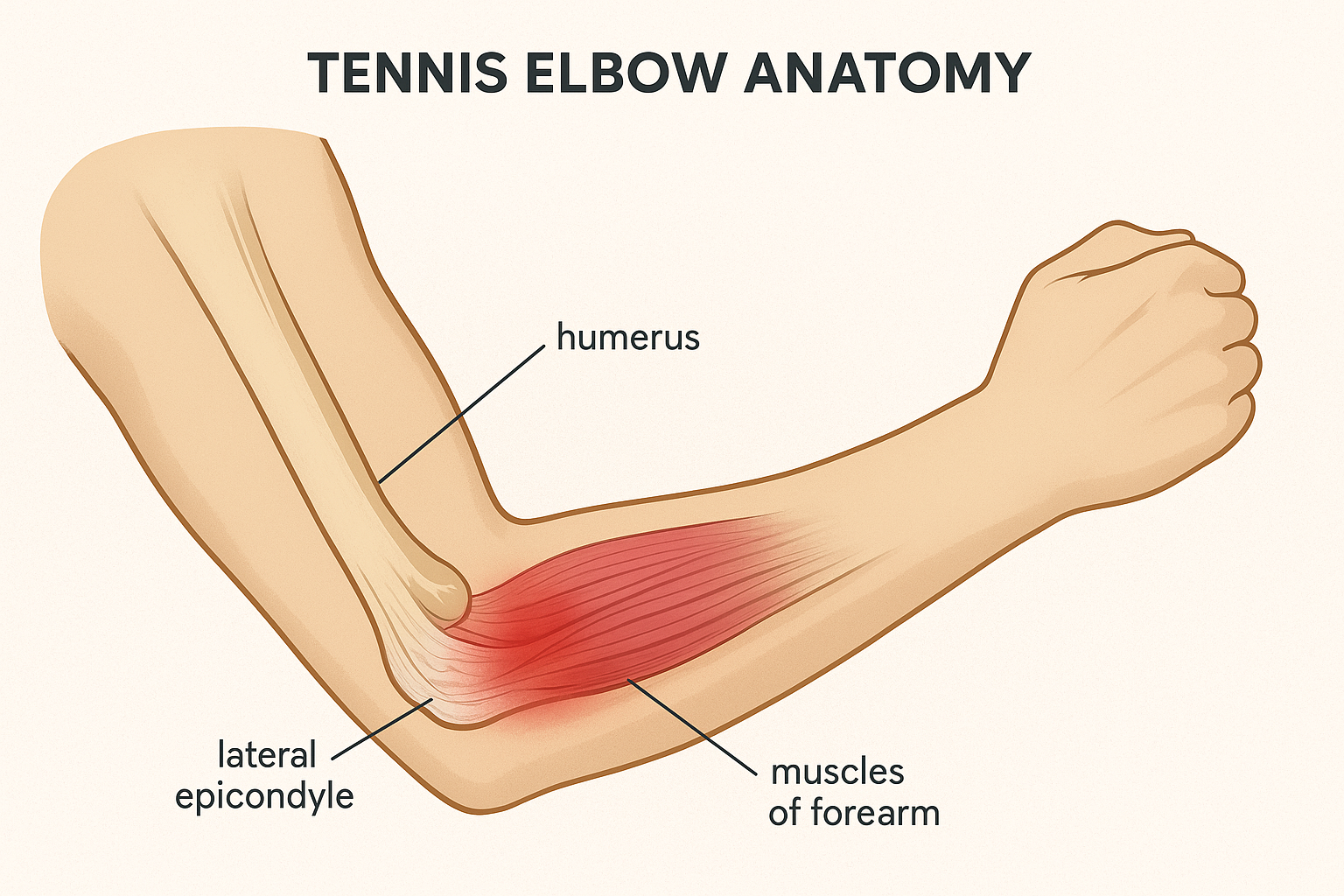Lateral epicondylitis, commonly referred to as tennis elbow, ranks among the most prevalent sources of arm discomfort in adult populations. Interestingly, the condition’s name can be misleading—most people who develop this painful ailment have never stepped onto a tennis court. Gaining insight into the mechanics of this condition, available treatment pathways, and its connection to biological aging empowers individuals to identify symptoms promptly and pursue effective care.
Defining Lateral Epicondylitis

Lateral epicondylitis develops when repetitive arm and wrist movements place excessive strain on the elbow’s tendons. The condition primarily affects the extensor carpi radialis brevis (ECRB) muscle, which plays a crucial role in wrist stabilization during arm extension. When these tendons connecting forearm muscles to the lateral epicondyle (the bony protrusion on the elbow’s outer side) become compromised, pain and dysfunction follow.
The characteristic discomfort typically emerges gradually rather than suddenly. Initial symptoms present as subtle aching sensations along the elbow’s exterior, which may extend toward the wrist and forearm. Movements involving grasping, rotating, or lifting intensify the pain. Everyday activities that most take for granted—extending a handshake, rotating door handles, grasping beverage containers, or operating computer keyboards—can transform into surprisingly painful challenges for those experiencing this condition.
Tennis players certainly encounter this injury due to the repetitive nature of backhand strokes, but the condition affects a much broader demographic. Individuals in professions requiring sustained forearm muscle engagement face elevated risk. House painters, plumbing professionals, carpentry workers, meat processing staff, and even desk-bound employees performing extended keyboard and mouse operations commonly develop lateral epicondylitis. The common denominator across these diverse groups is sustained, repetitive tendon stress.
The Science Behind the Condition
Medical understanding of tennis elbow has evolved considerably over recent decades. Historically, practitioners viewed the condition primarily through an inflammatory lens, reflected in the “epicondylitis” terminology (indicating epicondyle inflammation). Contemporary research reveals that chronic presentations are more accurately characterized as degenerative processes termed tendinosis rather than inflammatory tendinitis. This distinction carries significant implications for therapeutic approaches.
Tendinosis involves cellular-level degenerative alterations within tendon tissue. The typically well-organized collagen fibre arrangement becomes disrupted and chaotic. The tendon demonstrates evidence of maladaptive healing responses featuring immature, structurally inferior collagen formation. Additionally, affected areas show proliferation of blood vessels and nerve fibres, contributing significantly to pain perception. Rather than active inflammatory processes, what occurs represents unsuccessful healing attempts wherein the body generates substandard tissue that remains vulnerable to continued damage.
Treatment Pathways and Management Strategies
Encouragingly, research indicates that 80-95% of tennis elbow cases respond favourably to non-operative interventions. Success requires patience combined with comprehensive strategies addressing both symptomatic relief and root causes.
Non-Invasive Treatment Foundations
Activity modification and rest constitute the primary treatment pillars. This approach doesn’t mandate complete immobilization but rather involves avoiding or adjusting movements that provoke symptoms. Identifying and addressing the repetitive patterns that initiated the problem proves essential for preventing recurrence.
Cold therapy applications can effectively manage acute discomfort and any inflammatory components, particularly during early phases. Fifteen-to-twenty-minute ice applications multiple times daily provide relief and help reduce swelling.
Physical therapy frequently serves as the treatment cornerstone. Qualified therapists develop customized programs incorporating flexibility-enhancing stretches, progressive strengthening protocols, and biomechanical optimization techniques. Eccentric exercise protocols, involving controlled muscle lengthening under resistance, demonstrate particular efficacy for tendinopathy management. These exercises facilitate damaged tendon tissue remodelling and encourage proper healing patterns.
Medical Treatment Options
Non-steroidal anti-inflammatory medications (NSAIDs) such as ibuprofen help manage discomfort and address inflammatory components, though judicious use is warranted given chronic tennis elbow’s predominantly degenerative rather than inflammatory nature.
Counterforce bracing worn on the forearm immediately below the elbow helps alleviate affected tendon stress by distributing forces more broadly. Many individuals experience substantial relief through this straightforward intervention.
Corticosteroid injection therapy has traditionally featured in tennis elbow management. While these injections can deliver short-term pain reduction, emerging evidence suggests potential long-term healing impairment and elevated recurrence risk. Consequently, their application has become more selective, typically reserved for cases where pain severely limits function.
Platelet-rich plasma (PRP) injection therapy represents a newer modality involving concentrated platelet injection from the patient’s blood into affected regions. The growth factors within PRP may stimulate healing processes, though research regarding effectiveness yields mixed conclusions.
Extracorporeal shockwave therapy employs acoustic wave energy to stimulate affected tendon healing and shows encouraging outcomes in various studies, particularly for chronic cases resistant to alternative treatments.
Surgical Interventions
When conservative approaches prove unsuccessful following 6-12 months, surgical intervention may warrant consideration. Surgical procedures typically involve diseased tissue removal and healthy tendon reattachment to bone. Surgery generally yields favourable success rates with most patients experiencing marked improvement, though recovery necessitates several months of rehabilitation.
Structured Home Exercise Programs
For individuals managing chronic tennis elbow at home, structured exercise protocols executed consistently can prove highly effective. The following routine, developed by sports medicine professionals, emphasizes gradual tendon strengthening and normal function restoration through targeted movements.
Proper warm-up preparation proves essential before commencing any exercise regimen. This should encompass arm rotations (20 forward and 20 backward directions), bilateral wrist rotations, and gentle outer elbow area massage. This preparatory phase increases blood circulation and prepares tissues for subsequent exercises.
The home program’s foundation involves eccentric wrist extension movements. This exercise requires sitting with the forearm supported on a table surface, palm oriented downward, while grasping a light dumbbell (0.5-2 kg range). The opposite hand assists with upward wrist lifting, followed by controlled 3-4 second lowering. This controlled descent phase delivers the therapeutic benefit, as eccentric loading promotes tendon remodeling. Daily execution of 10-12 repetitions across 2-3 sets can produce significant improvements over time. Mild discomfort represents expected responses, but sharp pain should prompt exercise cessation.

Video: Eccentric Wrist Extension Demonstration
https://www.youtube.com/watch?v=iztqfOusW_s
Finger band extension movements help balance forearm musculature by targeting extensor muscles. Using resistance bands positioned around all five digits, slowly spreading fingers outward then returning to starting positions for 15 repetitions across 2 sets improves overall forearm strength and coordination.
Video: Finger Band Extensions Demonstration
https://www.youtube.com/watch?v=zAwwQ75xK7A
Towel twist exercises build forearm endurance by simulating functional gripping and twisting motions. Grasping a rolled towel with both hands and twisting as though wringing water for 10 twists in each direction across 2 sets helps prepare the arm for daily activities.
Video: Towel Twist Exercise Demonstration
https://www.youtube.com/watch?v=b42kdZF_BtA
Every session should conclude with appropriate stretching and cool-down. With extended arm and downward-facing palm, gently drawing fingers backward toward the body for 20 seconds stretches extensors. With upward-facing palm, gently pulling fingers downward for 20 seconds stretches flexors. Concluding with light affected area massage for 30-60 seconds promotes circulation and relaxation.
Consistency proves crucial with home exercise protocols. Most programs recommend tracking progress across 6-week periods, documenting completed days and pain level or functional improvement changes. Mild exercise-related soreness represents normal expected responses, but sharp or intensifying pain indicates the need for intensity reduction or professional guidance. Home exercise programs should complement rather than replace professional medical counsel, and persistent or worsening symptoms warrant physiotherapist or sports medicine specialist consultation.
The Connection to Aging
The relationship between lateral epicondylitis and biological aging demonstrates significant and multifaceted characteristics. Tennis elbow most frequently affects individuals aged 30-50 years, with peak occurrence around ages 40-50. This age-related pattern isn’t coincidental; it reflects fundamental tendon biological changes accompanying aging processes.
Age-Related Tendon Degeneration
As biological aging progresses, tendons experience multiple changes increasing injury susceptibility and diminishing healing capabilities. Collagen production decreases, and produced collagen becomes less organized with increased cross-linking propensity, rendering tendons stiffer and less elastic. Tenocytes, the cellular tendon components, become less numerous and metabolically active with advancing age. Tendon blood supply may also diminish, further compromising healing capacity.
These age-related alterations mean repetitive activities that tendons tolerated readily during twenties and thirties may begin causing problems during the forties and beyond. Cumulative decades-long use effects combined with diminished regenerative capacity create ideal conditions for tendinopathy development.
Diminished Regenerative Capacity
Among the most significant aging-related aspects of tennis elbow is impaired healing responses. When younger tendons sustain repetitive activity micro-damage, they typically repair themselves efficiently during rest periods. However, aging tendons lose this regenerative efficiency. Micro-damage accumulation outpaces repair capacity, eventually producing the degenerative changes characterizing tennis elbow.
Growth factor production and other repair-coordinating signaling molecules also decline with age. This means older adults developing tennis elbow may experience longer resolution times and increased chronicity likelihood compared to younger individuals with identical injuries.
Broader Implications for Healthy Aging
Conditions like tennis elbow contribute to broader understanding of tissue aging and has implications for anti-aging research efforts. Strategies under investigation for promoting healthier tendon aging include nutrition optimization (particularly ensuring adequate vitamin C essential for collagen synthesis), maintaining regular yet appropriate physical activity levels, and exploring interventions potentially enhancing tendon regeneration.
Emerging research suggests certain supplements like collagen peptides may support tendon health, though evidence continues developing. Exercise, when appropriately calibrated, helps maintain tendon health by stimulating collagen production and improving circulation. The critical factor involves achieving proper balance—sufficient stress to maintain tissue health without causing cumulative damage.
Preventive Strategies
Understanding aging-related tennis elbow aspects underscores prevention importance, particularly with advancing age. Proper work and recreational activity ergonomics, regular forearm and wrist strengthening and flexibility exercises, gradual new activity progression, and adequate recovery time allowance between repetitive tasks all help reduce risk.
Final Thoughts
Lateral epicondylitis represents a common intersection where repetitive stress meets age-related tissue changes. While the condition can prove frustrating and painful, understanding its true degenerative rather than inflammatory nature has improved treatment approaches. The strong aging connection reflects broader tissue change patterns over time, making tennis elbow not merely an orthopedic concern but also a window into aging processes themselves. With appropriate treatment, patience, and prevention attention, most individuals can successfully overcome tennis elbow and resume normal activities, though the experience often reminds us of the importance of caring for our bodies throughout the aging process.




Add Comment